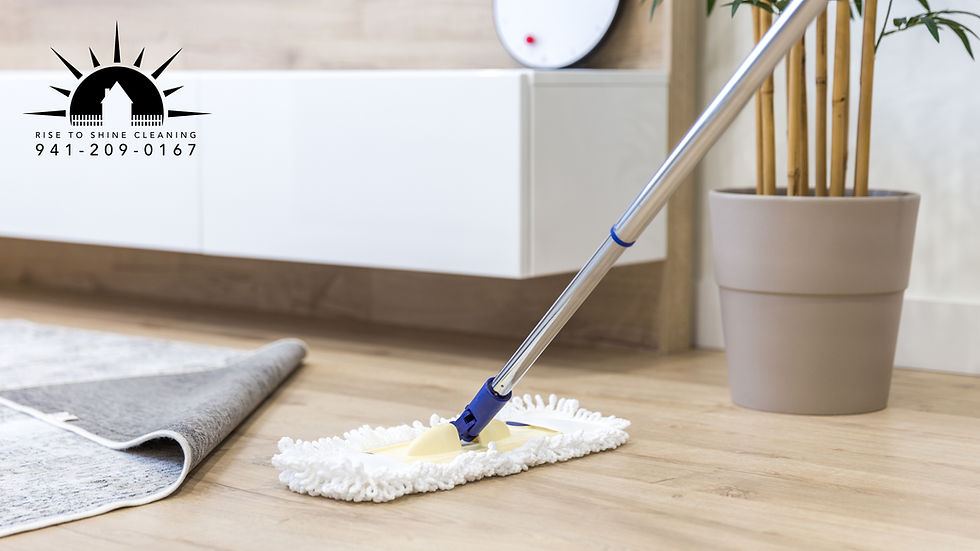The Ultimate Guide to Choosing the Best Mops and Managing Your Mopping Expectations
- iDea Concepts, LLC Todd Sellitto

- Aug 22, 2024
- 3 min read
When it comes to maintaining a pristine home, mopping is an essential task that can make a significant difference. However, the effectiveness of mopping largely depends on the type of mop you use and how you approach the task. At Rise to Shine Cleaning, we understand that the right tools and techniques can transform your cleaning routine. Here’s a comprehensive guide to the best mops available and what you should expect when mopping.
Choosing the Best Mops for Your Needs
Microfiber Mops
Pros:
Absorbency: Microfiber mops are highly absorbent and can hold several times their weight in liquid. This makes them perfect for tackling spills and heavy-duty cleaning.
Efficiency: The fine fibers trap dirt and dust effectively, making them ideal for both wet and dry mopping.
Durability: They are machine washable and can last a long time with proper care.
Cons:
Initial Cost: They might be pricier than traditional mops, but their efficiency and longevity can offset the initial investment.
Best For: Homeowners who want a versatile mop that excels in both dirt and liquid absorption.
Spin Mops
Pros:
Ease of Use: Spin mops come with a built-in wringer that helps you control the amount of water on the mop head, making it easier to clean without leaving excess water on the floor.
Convenience: The spinning mechanism reduces the need to manually wring out the mop, saving time and effort.
Cons:
Size and Storage: The bucket and spinner can be bulky, requiring more storage space.
Best For: Those looking for a user-friendly mop that minimizes manual wringing and reduces cleaning effort.
Steam Mops
Pros:
Sanitization: Steam mops use hot steam to kill bacteria and germs, providing a higher level of sanitization compared to traditional mops.
Chemical-Free: They clean without the need for chemical cleaners, making them an eco-friendly option.
Cons:
Heat Sensitivity: They may not be suitable for all floor types, particularly those sensitive to heat like certain laminates or unfinished wood.
Best For: Families with young children or pets, and anyone looking for a chemical-free cleaning solution.
Sponge Mops
Pros:
Absorbency: Sponge mops are excellent at soaking up liquids and are easy to wring out.
Cost-Effective: They are typically less expensive and readily available.
Cons:
Durability: Sponge mops can wear out relatively quickly and may need frequent replacement.
Cleaning: They can be harder to clean thoroughly after use, potentially harboring bacteria.
Best For: Budget-conscious individuals needing a straightforward mop for everyday use.
Flat Mops
Pros:
Versatility: Flat mops are often designed to be used with disposable or washable pads, making them adaptable for various cleaning tasks.
Storage: They are slim and easy to store, taking up less space in your cleaning closet.
Cons:
Coverage: They may not be as effective for scrubbing tough stains compared to other mop types.
Best For: Those who prefer a low-maintenance mop and value easy storage.
Setting Realistic Expectations When Mopping
Preparation is Key:
Clear the Area: Move furniture and other items out of the way to ensure you can clean every corner of the floor.
Dust First: Dusting or vacuuming before mopping prevents dirt from turning into a muddy mess.
Use the Right Amount of Water:
Avoid Over-Wetting: Too much water can damage floors, especially wood and laminate. Ensure your mop is damp but not dripping.
Change Water Frequently: For best results, change the water in your mop bucket regularly to avoid spreading dirt around.
Proper Technique:
Mop in Sections: Divide your floor into sections and mop one area at a time to ensure even cleaning.
Mop in a Figure-Eight Pattern: This technique helps to clean and lift dirt more effectively.
Drying Time:
Allow Time to Dry: After mopping, let the floor air dry. Avoid walking on the freshly mopped floor until it’s completely dry to prevent streaks and slipping.
Maintenance:
Clean the Mop Head: Rinse and wash the mop head after each use to keep it hygienic and effective.
Inspect Regularly: Check for signs of wear and replace mop heads or components as needed to maintain performance.
Conclusion
Choosing the right mop and understanding what to expect during the mopping process can elevate your cleaning routine from ordinary to exceptional. Whether you opt for the versatility of a microfiber mop, the convenience of a spin mop, the sanitizing power of a steam mop, the affordability of a sponge mop, or the practicality of a flat mop, each has its unique benefits and ideal uses. Combine the right tools with effective techniques, and you’ll achieve sparkling, clean floors with ease. At Rise to Shine Cleaning, we’re committed to helping you find the perfect mop for your needs and ensuring your home shines like never before.





Comments